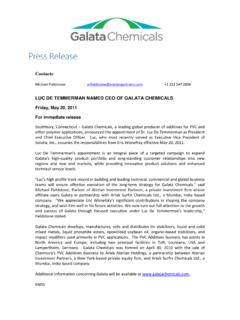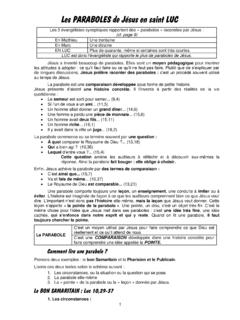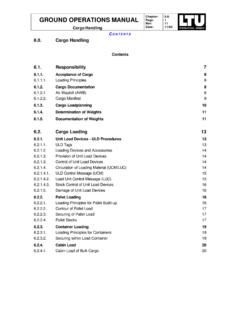Transcription of Luc De Wilde 14-00 - ASM Consortium
1 Operator reliabilitytaking automation to the next levelAutomation and Control for EnergyManchester, 10-11 may 20st century joke in the world of Process AutomationQuestion : How many resources do you need to run a refinery ?How many resources do you need to run a refinery ?Answer : Two : one operator and one dogThe operator is there to feed the dogThe operator is there to feed the dogThe dog is there to make sure that the operator doesn t touch 20st century Automation Engineers heaven :100% automated plants100% automated plantsNo more operators, no more human errorsInfinite workforce productivityJust a matter of time and a matter of time and resources .. ?Major investment effort Digitalize all controls Develop software applications and optimizers2003titUPS 2003, voting systems, UPS, .. Fool-proof SIS, Layers of Protection, risk matrix ..In the meantime, human errors continued to happen with evolving diagnosis ~1970 : Humans are not machines 1980 : residual problem from the past will soon be solved ~1980 : residual problem from the past, will soon be solved ~1985 : need more detailed procedures for remaining human interventions ~1990 : problem to transfer competency to new generation operators ~1995 : need behavioral program.
2 So that procedures are followed ..421stcentury : several wake-up calls5 Human Performance Error in operations and maintenance functions = still major risk contributor2007-0652008-0262008-0282008- 0592008-061 Burns byEthyleneSelection of reported accidents and near misses, 2007 - 2009 Burns by caustic soda during operator intervention at a pumpWorker spread with sulphuric acidWorking on a blind while system still in serviceWorker spread with sulphuric acidEthylene ship connected to propylene loading arm2008-0652008-0702008-0722009-0142009- 0206 Isobutane cloud after rupure of nitrogen hose during startupLarge benzene spill in pipewayHot quench oil spread on operator after manometer removalLarge fuel oil spill after contractor opened purgeFire during furnace startup Classical (20st century) approach of AutomationOperator = (un)avoidable source of errors and lossesHuman errors are at the origin of gmany incidents of process safety, reliability, ..Automation objective = avoid depending on human interventionTechnology = a tool to reduce the exposure of the process to human ittid7intervention and errorsOperator error = caused by not following procedures and / or lack of competencyHuman error :2 most observed root causes8 Just aspects of a more complex reality Humans are not.
3 So we cannot do anything ..Let s do AT LEAST what we, engineers, do for machinery:- ensure utilisation in their optimum operating range- install alarming and overload protection - ensure long lifetime with a maintenance plan-design an adapted control scheme to influence their functioning9des g a adapted co t o sc e e toue ce t e u ct og- use our expertise to constantly enhance their RELIABILITY= the ( hard ) science of Human & Organisational FactorsHuman& OrganisationalFactors : domainBasis = brain functioning Handling of conflicting priorities Tunnel effect Types of memory Mental modes of operation ..Understanding of human errormechanisms and influencingfactors10 HARD science : fully quantifiedAppliedscience : nuclearindustry, aviation industry, military ..Human Error typology in the Process Industry :Classification according to CCPSA ctive failuresLatent conditionsSlipMistakeLapsViolationSocio- technicalMgt / Intent bAction asintended bError inmemoryllIntendedaction thatd liblBased on teambh uncleargoal setting,ldfi dIn combinationwith activefailure, willresult in incident11butfailure inexecutionbutintentionwas wrongrecalldeliberatelyignores aknown rule,restriction orprocedurebehaviourpoorly definedresponsibilities,tools and interfaces poorly adapted to human capabilities.
4 Expertise failureLack of expertiseShortcutOptimisingNecessaryExce ptionalIncludesMgt/ org. failureThe human control loop of the operatorOperator Mental & Physical Activities ProcessStateOperator Mental& Physical Activities Situation Awareness (1-3) Inputs from Process(sensors, analyzers, radios, video, instructions, sounds & smells)(1) Sensing, Perception, and/or Discrimination(2) Analysis, Interpretation,and/or(3) ProjectionPhysical and/or Verbal ResponseOutputs to Process(SP, OP%, Manual adjustments)Internal FeedbackEvaluatingOrientingActing-Inputs from Process(sensors, analyzers, radios, video, instructions, sounds & smells)(1) Sensing, Perception, and/or Discrimination(2) Analysis, Interpretation,and/or(3) ProjectionPhysical and/or Verbal ResponseOutputs to Process(SP, OP%, Manual adjustments)Internal FeedbackEvaluatingOrientingActingSituati on Awareness 12 External FeedbackAssessingExternal FeedbackAssessingFigure from the ASM ConsortiumAdaptation of Supervisory Control Activity models of Jens Rasmussen and David Woods - which influence the overall intervention success of the operatorOrientingEvaluating Information overloadActingAssessing Missing information Inappropriate level of detail Vigilance decrement Difficult navigation Distracting environment Inconsistent information Inaccurate information Conflicting priorities Lack of knowledge Inappropriate detail Poor information accessibility Inadequate communications Deficient / complex procedures Fail to follow procedures Inappropriate actionsInappropriate tools / Lack big picture view Inaccurate information13accessibility Inappropriate tools / interface Lack of experience Inadequate feedbackinformation Inadequate information Erroneous conclusionsRed= human influencing factors which are
5 Directly impacted by available automation technology+ already applied in nuclear, aviation, ..21stcentury approach of AutomationOperator = unavoidable source of errors and lossesUnique human contribution = manage Operator = unique source of safety and reliabilityHuman errors are at the origin of qgabnormal situations(anticipate, detect, respond) in process safety, reliability, ..Automation objective = maximize the operator s impact on his processTechnology is a tool to boost the HR li bilitfthtgmany incidents of process safety, reliability, ..Automation objective = avoid depending on human interventionTechnology = a tool to reduce the exposure of the process to human ittid14 Human Reliability of the operatorOperator error = failure of operational and technical managementto adapt work to human characteristics of operatorintervention and errorsOperator error = caused by not following procedures and / or lack of competencyHuman limitations for reliable alarm response(norm EEUMA, measured by the ASM Consortium as upper bound)Type of problemMaximum targetper operatorStanding alarms<10 Background alarms<10 per hourAlarm flooding<10 in first 10 minutes ofupset15 Beyond these limits, human operator response is structurally unreliableAllowing such installation to operate without compensating measuresis a management failureThe role of Operational and TechnicalManagement = installingLayers of Protection16 Figure from CCPS websiteEffective alarm management= a vital Layer of ProtectionAlarm Management.
6 Part of Process Safety Cultureand Operational ExcellenceSupporting the operator as unique source of safety and reliabilityOperations-centered approach : technology boosts human performanceOperational professionalism as core competency17 Transverse competencies remain THE key element for Automation success in the 21stcenturyProcess Automation & DCS expertiseProcess design and engineeringscience20stcenturyOwns technology SOLUTIONS engineering scienceOwns the NEEDSP rocess Automation & DCS expertiseConduct of Operations and HUMAN FACTORS 21stcenturyABNORMAL SITUATIONS MANAGEMENT CONSORTIUM18 Owns technology SOLUTIONS scienceOwns the NEEDSR&D Consortium of 15 companiesand universities Initially co-funded by US Govt(NIST) The state-of-the-Art lab for technology - enhanced Human Reliability of the Operator :Abnormal Situation Management Consortiumyy()+$16M for first 4 years Jointly invested +50M$ over 15 years Creating knowledge, tools and products designed to prevent, detect and mitigate abnormal situationsthat affect process safety in the control operations environmentCharter Stage 1 (1994-1998) : Research Stage 2 (1999-2001) : Prototyping19g()yg Stage 3 (2002-2004) : Development Stage 4 (2005-2008) : DeploymentDeliverables Technology, prototypes, guidelines, best practices, metrics, application knowledge, workshops, productsR&D domain of the ASM ConsortiumTechnology to radically enhance the operational teams capability to : Error-free DETECT indicators and precursors Error-free DECIDEon appropriate course of actions Error-freeRESPONDand execute corrective actionsErrorfree RESPONDand execute corrective actionsin order to PREVENTor MITIGATEany abnormal situationEmergency20 TimeImpactNormalAbnormalEarlier awareness, more informed responseHow ?
7 By focusing on following 7 areas1. Understanding ASM- Focuses on issues that can lead to a better understanding of current incident causes providing insight to reduce future abnormal situations and to prepare operations teams accordingly2 Management Structure & PolicyFocuses on the impact Structure & Policy-Focuses on the impact of management structure and policy on the ability of the operations team to prevent and respond appropriately to abnormal situations3. Training & Skill Development- Focuses on the impact of training and skill development, in anticipating and coping with abnormal situations4. Communications- Focuses on communications issues among plant personnel and with the use of information technology under normal, abnormal and emergency situations5. Procedural Operations- Focuses on all aspects of procedures used to accomplish important tasks at an industrial site, particularly startup/shutdown21startup/shutdown6. Control Building & Operations Environment- Focuses on the impact of the control building environments on effective operations7.
8 Process Monitoring Control & Support - Focuses on process monitoring, control and support applications for effective operations. It includes such aspects as alarm management and early event :1. After decades of automation, the human operator s unique and irreplaceable contribution has become to manage abnormal solutions, interfaces andtoolswillonlybeeffective solutions, interfaces and toolswillonlybeeffective if theytake into account the hard science of Human Factors. This science should become a core competency for automation The challenge for the Process Automation profession in the 21stcentury will be, to use technology for a radical enhancement of the operator s human reliabilityand his impact on the process in all normal and abnormal The Abnormal Situation Management Consortium plays an essential role in advancing technology to boost the human reliability of the operator. In its pursuit for operational excellence, Total is proud to contribute as a Safetyis why you do it.
9 Reliabilityis how you pay it !23








